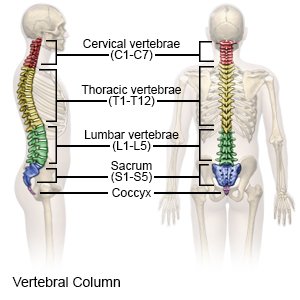Sacral Fracture
Medically reviewed by Drugs.com. Last updated on Apr 6, 2025.
AMBULATORY CARE:
A sacral fracture
is a break in the triangle-shaped bone found at the bottom of your spine. The fracture is often caused by injury or weak bones.
 |
Common signs and symptoms include the following:
- Low back, buttock, or hip pain
- Pain in the front of your thigh and your groin
- Bruising and swelling around the sacral area
- Leg weakness
Seek care immediately if:
- Your leg tingles or feels like pins are being stuck in it.
- Your leg feels numb or weak.
- You have problems controlling your urine or bowel movements.
- Your leg feels warm, tender, and painful. It may look swollen and red.
Call your doctor if:
- You have pain or swelling in your low back area, hip, or buttock that gets worse.
- You have questions or concerns about your condition or care.
Treatment for a sacral fracture
will depend on how severe it is. Mild sacral fractures that were caused by increased activity may be treated with rest alone. Medicine to decrease pain may be given so that you can return to your usual activities as soon as possible. After your fracture has healed, you may need an exercise program to increase your flexibility. Severe sacral fractures may require surgery to place your bones in their normal positions.
Rest:
Rest when you feel it is needed. Slowly start to do more each day. Return to your daily activities as directed. Use a pillow when you sit to decrease the pressure on your sacrum.
Physical therapy
is used to teach you exercises to help improve movement and strength, and to decrease pain.
Follow up with your doctor as directed:
Write down your questions so you remember to ask them during your visits.
© Copyright Merative 2025 Information is for End User's use only and may not be sold, redistributed or otherwise used for commercial purposes.
The above information is an educational aid only. It is not intended as medical advice for individual conditions or treatments. Talk to your doctor, nurse or pharmacist before following any medical regimen to see if it is safe and effective for you.
Further information
Always consult your healthcare provider to ensure the information displayed on this page applies to your personal circumstances.
